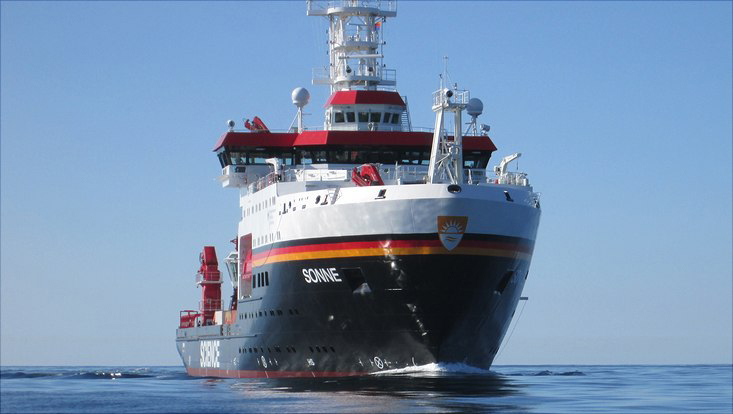Secrets of the Indian OceanResearch vessel SONNE heads for little-known coral reefs
4 September 2019, by CEN Universität Hamburg

Photo: M. Hartig/Meyer Werft
On September 6, 2019, the German research vessel SONNE embarks on a 2-month expedition, headed by geologist Dr. Sebastian Lindhorst from Universität Hamburg’s Center for Earth System Research and Sustainability. The destination is an underwater system of coral reefs the size of Switzerland in the Indian Ocean, which due to its remote location has barely been investigated to date.
The Saya de Malha Bank rises from the 2000-meter-deep seabed to just below the ocean surface. It lies between Mauritius and the Seychelles, in the flow of the strong South Equatorial Current. The abundance of food and the current make the reefs a feeding paradise for fish and whales. At the same time, magnificent corals also thrive here.
“We want to discover how the water masses from the south mix with the nutrient-rich waters flowing from the north, and what effect this has on the formation of the reefs,” says Dr. Sebastian Lindhorst, who is leading the expedition. “It’s likely that sea-level fluctuations as well as the currents affect their development, causing them to grow or to shrink.”
There are 40 researchers taking part in the expedition, including scientists from Universität Hamburg and the Helmholtz-Zentrum Geesthacht (HZG). They will join the ship in Hong Kong, from where the journey to Saya de Malha Bank will take a good two weeks. Once there, they will also investigate the impact of climate change on the coral reefs. The oceans take up roughly a quarter of the CO2 produced by humans, which causes the pH to fall, and they become acidic. Coral is particularly sensitively to this.
For the first time, the scientific crew will follow the course of certain microplastic particles and pollutants from China to the Bank. The aim is to find out how they drift in the ocean and where they end up.
The researchers are interested in both the present and the future – as well as the past. They will measure the salinity and temperature of the seawater around the clock, and will also investigate the nutrients and pollutants, as well as sediments on the ocean floor. The latter provide insights into the past climate. As Professor Kay-Christian Emeis from the HZG explains: “Taking core samples from the sediment allows us to look up to 200,000 years into the past. The sediments are a veritable climate archive, which offers us new insights into the monsoon system and the history of its development in the region.”
SONNE’s research expedition is funded by German Federal Ministry of Education and Research.
Additional material:
Press picture seaturtle:
http://uhh.de/cen-meeresschildkroete
Green sea turtles find rich pickings in the shallow waters of Saya de Malha Bank.
360-degree virtual tour of the SONNE, one of the world’s most modern research ships:
Expedition blog:
https://mascara.blogs.uni-hamburg.de/
Contact:
Prof. Christian Betzler (Leader of the project)
Universität Hamburg / Center for Earth System Research and Sustainability (CEN)
Institute for Geology
Tel.: +49 40 42838-5011
E-Mail: christian.betzler@uni-hamburg.de


